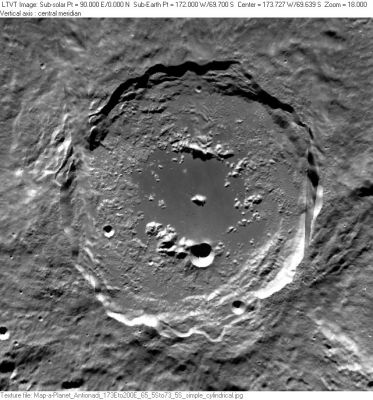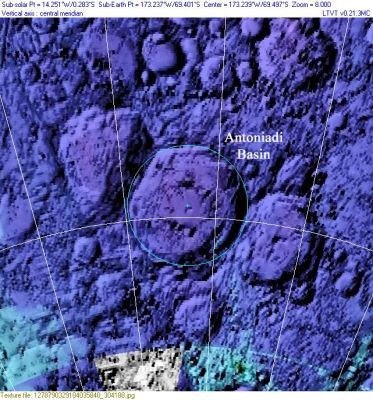Difference between revisions of "Antoniadi"
| Line 7: | Line 7: | ||
|- | |- | ||
| | | | ||
| − | [http://www.lpod.org/coppermine/albums/userpics/Antoniadi_MapAPlanet_Clementine_100ppd_LTVT.JPG [[Image: | + | [http://www.lpod.org/coppermine/albums/userpics/Antoniadi_MapAPlanet_Clementine_100ppd_LTVT.JPG [[Image:Normal_Antoniadi_MapAPlanet_Clementine_100ppd_LTVT.JPG|external image normal_Antoniadi_MapAPlanet_Clementine_100ppd_LTVT.JPG]]]<br /> |
| | | | ||
| − | [http://lpod.org/coppermine/displayimage.php?pid=4663&fullsize=1 [[Image: | + | [http://lpod.org/coppermine/displayimage.php?pid=4663&fullsize=1 [[Image:Normal_Antoniadi.jpeg|external image normal_Antoniadi.jpeg]]]<br /> |
|} | |} | ||
<div id="toc"> | <div id="toc"> | ||
| Line 37: | Line 37: | ||
<br /> | <br /> | ||
==Description== | ==Description== | ||
| − | One of only two central peak ring basins on the Moon. This is a transitional landform between normal craters and two-ring impact basins. <span class="membersnap">- tychocrater <small>Aug 26, 2007</small></span><br /> <br /> | + | One of only two central peak ring basins on the Moon. This is a transitional landform between normal craters and two-ring impact basins. <span class="membersnap">- [http://www.wikispaces.com/user/view/tychocrater [[Image:Tychocrater-lg.jpg|16px|tychocrater]]] [http://www.wikispaces.com/user/view/tychocrater tychocrater] <small>Aug 26, 2007</small></span><br /> <br /> |
==Description: Wikipedia== | ==Description: Wikipedia== | ||
[http://en.wikipedia.org/wiki/Antoniadi_%28lunar_crater%29 Antoniadi]<br /> <br /> | [http://en.wikipedia.org/wiki/Antoniadi_%28lunar_crater%29 Antoniadi]<br /> <br /> | ||
Revision as of 18:43, 15 April 2018
Contents
Antoniadi Basin
(unofficial name; IAU crater name: Antoniadi, 143 km diam)
|
Lat: 69.7°S, Long: 172.0°W, Main ring diam: 140 km, Depth: ~4 km (farside) Upper Imbrian | |
Left: Clementine At least according to the Kaguya laser altimeter, the lowest point on the Moon is on the floor of the unnamed, but deeply shadowed, crater within Antoniadi. Right: Clementine LIDAR Altimeter-coded shaded relief image from Map-A-Planet.
Images
LPOD Photo Gallery Lunar Orbiter Images
Maps
(LAC zone 141B3) USGS Digital Atlas PDF
Basin Classification
(description of terms and most numeric basin data from Wood, C.A. (2004) Impact Basin Database)
| Certainty of Existence |
USGS Age |
Wilhelms Age Group |
Ring Diameters |
Mare Thickness |
Mascon |
| Definite |
12 |
65, 140 km |
No |
Description
One of only two central peak ring basins on the Moon. This is a transitional landform between normal craters and two-ring impact basins. - tychocrater tychocrater Aug 26, 2007
Description: Wikipedia
Additional Information
- First described as a basin by Hartmann and Wood, 1971.
- Based on the shadows in the available imagery, and on the Kaguya preliminary topographic map of the Moon, Antoniadi is 3 to 4.5 km deep. - Jim Mosher
- As an example of their detailed digital elevation models for the entire Moon based on analysis of photos by stereophotoclinometry, Gaskell & Mastrodemos(2008) have published a DEM for Antoniadi. In a DEM, the heights are represented by gray levels; but no height scale is provided for this DEM. The text of their article indicates the heights represented range from -0.7 to -8.8 km, however the low value is at the bottom of the 12.8 km crater at 70.41°S/172.61°W (on the southern floor of Antoniadi), which is itself 2.7 km deep according to the shadows in Clementine frame LUB0258B.203. The high value is at the peak of the ridge to the southeast of Antoniadi, which may or may not be related to the crater rim. Assuming the Gaskell & Mastrodemos DEM uses a linear scale, the elevation difference from points on the main rim to the main floor ranges from about 3100 to 5300 m. Both these points on the west rim cast shadows in Clementine frame LUF0120V.268 and measurement of them returns (probably more accurate) elevation differences of 2800 and 4500 m. - Jim Mosher
- The shadows in Clementine frame LUB0258B.203 indicate that the small peak at Antoniadi's center is 1.1 km tall. The peaks in the northern part of the central ring are taller, rising 1.6 to 2.2 km above the floor. The heights for these peaks indicated in the Gaskell & Mastrodemos DEM are roughly consistent with these, but much more uncertain due to artifacts which give the erroneous appearance of a rolling floor (making the reference level difficult to determine). - Jim Mosher
- Crater counts yield mare ages of 2.58 b.y. Haruyama, J. and others, 2008.
- Area of floor mare 2800 km2 and Eratosthenian age. Higher Fe mare surrounding rille in NW mare; therefore, two mare units. (Gillis and Spudis, 1996)
- According to laser altimetry mapping by the Kaguya spacecraft the lowest place on the Moon is within a small crater on the floor of Antoniadi. The highest point is on the rim of Engel'gardt. Reported in Planetary Society Blog.
- Within SPA basin, 90-98% anorthosite in central peak, and 0.1 to 0.4 Maturity Index (not mature) Ohtake and others, 2009
Nomenclature
- Crater named for Eugène Michel Antoniadi (1870 – February 10, 1944), a Turkish-born French astronomer . He became a highly reputed observer of Mars, and at first supported the notion of Martian canals, but came to the conclusion that canals were an optical illusion. He also observed Venus and Mercury. He is famed for creating the Antoniadi scale of seeing, which is commonly used by amateur astronomers.
- The impact basin is named after the crater.
- Hecataeus B, a crater at the moon's near side, was once called Antoniadi by Hugh Percy Wilkins and Patrick Moore.
- Rimae Antoniadi (a dedicated rille seeker's unofficial name for the rilles on the northern part of Antoniadi's floor).
LPOD Articles
LROC Articles
Bibliography
- Gaskell, R. W.; Mastrodemos, N. 2008. Lunar Topography from Stereophotoclinometry. 39th Lunar and Planetary Science Conference, (Lunar and Planetary Science XXXIX), held March 10-14, 2008 in League City, Texas. LPI Contribution No. 1391., p.1152
E. M. Antoniadi in the Sourcebook Project (William R. Corliss)
- In: Mysterious Universe, a handbook of astronomical anomalies (1979)
(this is a rather long list of articles, this list will gradually expand, probably within a couple of months)
- Illusions (Possible Markings on Venus, Vague Tracery and Radial Spokes) (Journal of the British Astronomical Association, 1897)
- Notes on the Rotation Period of Venus (Royal Astronomical Society, Monthly Notices, 1898)
- On some Objections to the Reality of Prof. Lowell's Canal System of Mars (Journal of the British Astronomical Association, 1910)
- Diplopia and Egg-Shaped Jovian Satellites (Journal of the British Astronomical Association, 1898)
- In: Rare Halos, Mirages, Anomalous Rainbows, and related electromagnetic phenomena (1984)
- Aerial Spectres (Journal of the British Astronomical Association, 1896) (Brocken Spectre, the Glory)
- Optical Phenomenon (Knowledge, 1895) (Anomalous Diverging Rays at Sunset and Sunrise)
- In: Lightning, Auroras, Nocturnal Lights, and related luminous phenomena (1982)
- The Light Which Spread over Constantinople at Night..., (Journal of the British Astronomical Association, 1906) (Glowing Night Skies)

